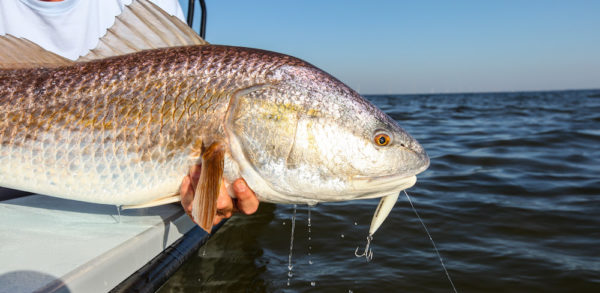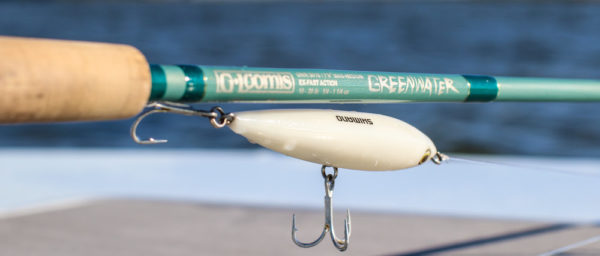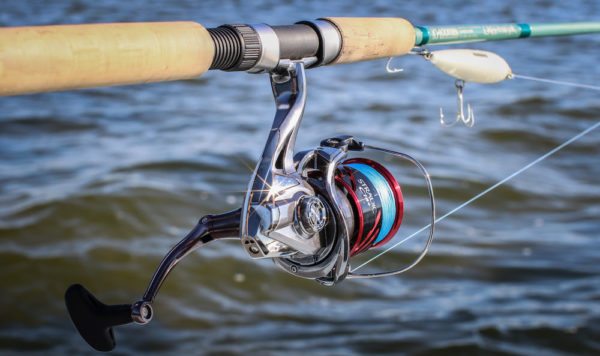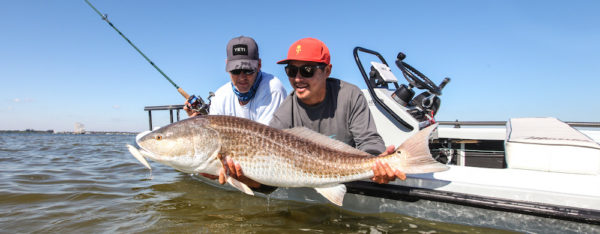Top Shelf – Current Sniper Redfish
Category: article
Sep 8th, 2022 by Keith Worrall
Modified Sep 8th, 2022 at 10:00 PM
Targeting Monster Redfish of Florida’s Banana River
Over the course of their lifetime, redfish might feed along shallow estuarine waters, brackish creeks, grass flats, mangroves, oyster beds, bridges, inlet jetties and beaches from Texas to the Chesapeake Bay. They know no boundaries and are not particular about the depth of water or clarity if forage is present. Yet, the red drum within Florida’s famed Banana River pretty much don’t ever leave, which surprisingly doesn’t make them any easier to catch.
Separating Merritt Island from Cape Canaveral, Cocoa Beach, Satellite Beach and Indian Harbor Beach, the 31-mile-long Banana River is an isolated lagoon that exists within a dramatic zone of climatic transition. Here, marsh and mangrove ecosystems flourish in a complex landscape where there is uniquely no tidal flow. There are no freshwater tributaries, no saltwater inlets, and the only outlet to the Atlantic Ocean is through a lock system at Port Canaveral.
A Cocoa Beach, Florida, local who has been guiding the Indian River Lagoon for years, G. Loomis ambassador Capt. Willy Le can’t help but reminisce of the days not too far gone when the Banana River was brimming with seagrass.

“This flat right here was so lush, the grass was thick as could be. But with water quality issues fueling massive seagrass die-offs, miles of underwater vegetation have been reduced to barren sand flats. There are still giant redfish, though they’ve changed behavior and where they would once tail and search out the seafloor, they now just cruise around looking for baitfish,” reflects Le.
With a blunt snout and sub-terminal downturned mouth, redfish are designed for digging and rooting around the bottom. They aren’t the most well-equipped species for attacking prey on the surface, but they can certainly display thrilling surface strikes as they track a topwater lure and eventually overtake the offering after several failed attempts.
Anglers imparting the appropriate snap of the rod tip can easily mimic distressed baitfish on the surface, but it’s important to choose a lure with the proper action for the prevalent conditions. When the Banana River becomes moderately choppy, topwater lures that emit loud noises draw in predators from a great distance. On calm days when glassy conditions put fish on high alert, it is better to fish with a walking lure that has a lower frequency and softer pitch, or one that is completely silent.

“We can sight during all hours of the day and in all weather conditions, but since redfish are focused on feeding early and late in the day this is when you will encounter the most cooperative topwater bite. With overcast conditions the topwater fishing can stay strong throughout the day,” says Le.
The Current Sniper family of topwater baits from Shimano offers anglers a lure for every scenario. The Current Sniper Walk 110F Silent is a walking bait that lacks internal rattles. It mimics a variety of natural forage and is ideal for the calmest mornings without a ripple on the water’s surface. The weather can quickly change in Florida and when the wind picks up it is wise to tie on the Current Sniper Walk Hi-Pitch, which is equipped with a glass fiber material that emits a high pitch rattle. Available in three sizes – 95 mm, 110 mm, and 130 mm – the durable Current Sniper Walk stands up to the most aggressive topwater bites.
Both of these proven topwater baits feature wire-through construction and measure just over four inches in length. Aboard the Maverick 18 HPX Native Fly, Le matches a size 4000 Stradic CI4+ with a 7’6” G. Loomis GCX Inshore spinning rod with Medium power and Extra Fast action. The action of this rod helps cast a heavy topwater lure and allows the angler greater control with a gliding walk-the-dog presentation.

Mature redfish tend to move in a slow, rhythmic pattern. They do not nervously dart around and typically push wakes at a steady pace in a straight line. The size of the wake is a good indication, with narrow, sharp pointed V-wakes likely created by mullet, compared to redfish with broad heads that produce a wider wave pattern.
Once a single, pair, or pod of redfish is spotted, it’s important to be patient and observe the activity before prematurely sending your topwater flying through the air. Nothing will spook a redfish faster than an improperly placed hard bait falling from the sky.

